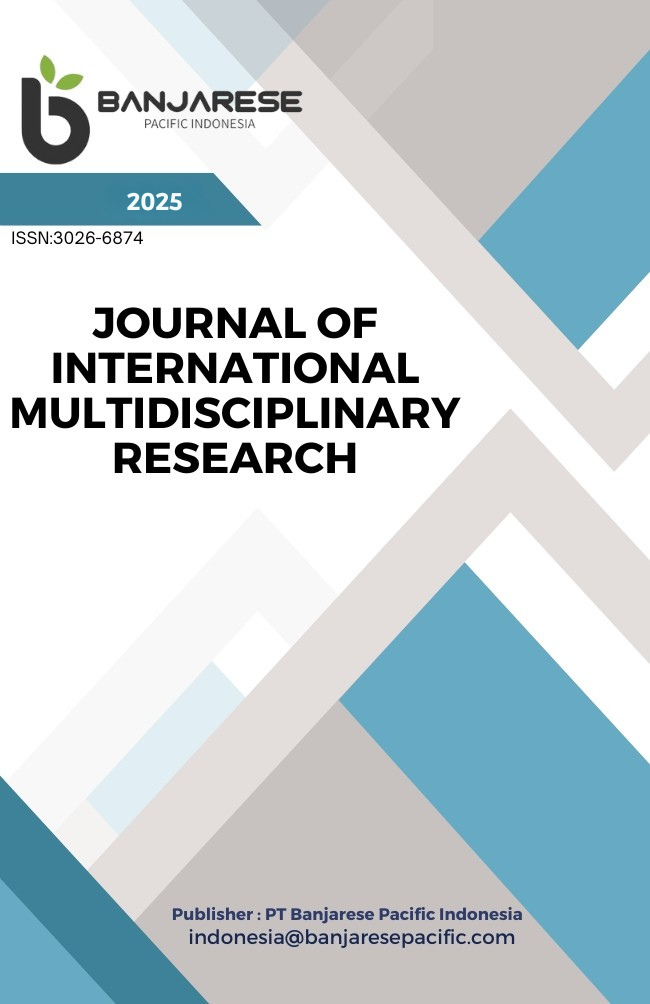The Effect of Gadget Use on Social Interaction Among Preschool Children in XYZ Sub-District, Surabaya
DOI:
https://doi.org/10.62504/jimr1264Keywords:
Digital Parenting, Early Childhood, Gadget Use, Social InteractionAbstract
This research examines the impact of gadget use on early childhood social interaction within the urban setting of XYZ Village, Surabaya, amid the growing prevalence of digital exposure among young children. Anchored in Vygotsky’s Sociocultural Theory and the Socialisation Theory, the study evaluates how the duration and frequency of gadget use influence key social competencies, including verbal communication, cooperative behavior, and empathy in children aged 3 to 6 years. Employing a quantitative, cross-sectional design, the study collected data from 100 children using parent-administered questionnaires and direct observational methods, followed by analysis through multiple linear regression. The findings demonstrate that both the duration and frequency of gadget use exert a statistically significant influence on children’s social interaction (p < 0.05), accounting for 19% of the variance (R² = 0.190). The remaining variation is likely influenced by external variables such as parenting styles, digital content quality, and psychological factors. These outcomes underscore the importance of regulated gadget use, active parental involvement, and integrative educational practices that promote both digital literacy and interpersonal development.
Downloads
References
Abdillah, A., Sufa, S. A., & Brumadyadisty, G. (2024). " HAPPY BARENG BIGGER BETTER " SCHOOL TO SCHOOL DI SURABAYA. 9(1), 266–284.
Anggraeni, N., & Listiana, A. (2023). The Role of Contemporary Pedagogical Technology in ECE: A Systematic Literature Review. Indonesian Journal of Educational Research and Review, 6(1), 99–110. https://doi.org/10.23887/ijerr.v6i1.55648
Briggs, S. R., & Cheek, J. M. (1986). The role of factor analysis in the development and evaluation of personality scales. In Journal of Personality (Vol. 54, Nomor 1, hal. 106–148). Blackwell Publishing. https://doi.org/10.1111/j.1467-6494.1986.tb00391.x
Cahyani, A. D., Atmaja, K. J., & Widodo, W. (2021). The Role of Parents in Monitoring the Negative Impacts of Gadget Usage for Early Childhood During Covid-19 Pandemic Era. https://doi.org/10.2991/assehr.k.211223.194
Carter, M. J., & Fuller, C. (2016). Symbols, Meaning, and Action: The Past, Present, and Future of Symbolic Interactionism. Current Sociology, 64(6), 931–961. https://doi.org/10.1177/0011392116638396
Coppola, G., Pastorino, G. M. G., Padovano, C., Scuoppo, C., Vivenzio, V., Simone, V. D., & Operto, F. F. (2021). Digitaltools and Language in Children Aged Between 8 to 36 Months. Archiv Euromedica, 11(5), 20–23. https://doi.org/10.35630/2199-885x/2021/11/5.5
Febriani, S., & Pandin, M. G. R. (2021). Effect of Gadget on the Development of Children During Pandemic Covid-19 Situation. Journal of Early Childhood Care and Education, 4(2), 83–91. https://doi.org/10.26555/jecce.v4i2.4276
Gath, M., Horwood, L. J., Gillon, G., McNeill, B., & Woodward, L. J. (2025). Longitudinal Associations Between Screen Time and Children’s Language, Early Educational Skills, and Peer Social Functioning. Developmental Psychology. https://doi.org/10.1037/dev0001907
Gomes, M. I. F., Lousada, M., & Figueiredo, D. (2024). Use of Digital Devices, Family Functioning, and Language Development in Preschool Children: A Cross-Sectional Study. Codas, 36(3). https://doi.org/10.1590/2317-1782/20232023125en
Hidayat, N., Sahbana, R., Devananda, P. A., Dianti, P. R., Manajemen, P. S., Pgsd, P. S., & Tarakan, U. B. (2024). Edukasi Penggunaan Teknologi yang Bijak di SDN 020 Tarakan Education on the Wise Use of Technology at SDN 020 Tarakan emosional karena di sebabkan miskin interaksi dan komunikasi dengan lingkungan sekitar ,. 6.
Huang, S. (2023). Impact of Children’s Digital Device Usage on Their Cognitive Function: A Comprehensive Literature Analysis. Lecture Notes in Education Psychology and Public Media, 26(1), 137–142. https://doi.org/10.54254/2753-7048/26/20230879
Ivana, I., Murniati, M., & Ayu Trisno Putri, N. R. I. (2021). The Relationship Between Gadget Usage and Adolescent Sleep Quality. Journal of Public Health for Tropical and Coastal Region, 4(1), 23–27. https://doi.org/10.14710/jphtcr.v4i1.10776
JudiJanto, L., Lubis, M. M., Riyadi, S., Krisprimandoyo, D. A., & Koentjoro, Y. (2023). Economic Innovation for Global Food Crisis: Technology-based Sustainable Solutions Review. Journal of Business Management and Economic Development, 2(01), 443–459. https://doi.org/10.59653/jbmed.v2i01.574
Luong, P. A. (2022). Applying the Concepts of “Community” and “Social Interaction” From Vygotsky’s Sociocultural Theory of Cognitive Development in Math Teaching to Develop Learner’s Math Communication Competencies. Vietnam Journal of Education, 6(3), 209–215. https://doi.org/10.52296/vje.2022.243
Nunnally, J. . (1978). Psychometric theory (2nd Editio). McGraw-Hill.
Operto, F. F., Pastorino, G. M. G., Marciano, J., Simone, V. D., Volini, A. P., Olivieri, M., Buonaiuto, R., Vetri, L., Viggiano, A., & Coppola, G. (2020). Digital Devices Use and Language Skills in Children Between 8 and 36 Month. Brain Sciences, 10(9), 656. https://doi.org/10.3390/brainsci10090656
Pallant, J. (2016). Survival Manual SPSS. McGraw-Hill Education, 187. www.openup.co.uk%0Aand
Setiani, D. (2020). The Effect of Gadget Usage on the Social Development of Children Aged 3-5 Years: Literature Review. Strada Jurnal Ilmiah Kesehatan, 9(2), 1732–1739. https://doi.org/10.30994/sjik.v9i2.526
Shafa, A., Desti, A., & Dikta, K. (2025). The Influence of Gadget Use on Early Childhood : Impacts and Strategies for Balanced Development. 3(1), 165–176. https://doi.org/10.69526/bir.v3i1.181
Sihotang, L., Gerrit, R., Kartika, E., & Novalina, M. (2021). Peran Orang tua Mengatasi Dampak Negatif Gadget pada Remaja Kristen. PROSIDING STT ERIKSON-TRITT, 1, 27–36. https://doi.org/10.53827/pros.v1i1.40
Siregar, A. O., & Yaswinda, Y. (2022). Impact of Gadget Use Cognitive Development. https://doi.org/10.2991/assehr.k.220602.035
Wahyuni, S., Bastian, A., & Nofrianti, S. (2021). Is There a Distinction in Socialization Ability Between Children Who Are Addicted to Gadgets and Those Who Are Not? A Comparison Study. Child Education Journal, 3(2), 110–122. https://doi.org/10.33086/cej.v3i2.1991
Wang, Z., Fang, Y., & Zhang, X. (2024). Impact of Social Capital on Health Behaviors of Middle-Aged and Older Adults in China—An Analysis Based on CHARLS2020 Data. Healthcare, 12(11), 1154. https://doi.org/10.3390/healthcare12111154
Downloads
Published
Issue
Section
License
Copyright (c) 2025 Yenny, Nurul Suhesti, Nevrettia Christantyawati, R. Ayu Erni Jusnita, Siska Armawati Sufa (Author)

This work is licensed under a Creative Commons Attribution-ShareAlike 4.0 International License.













